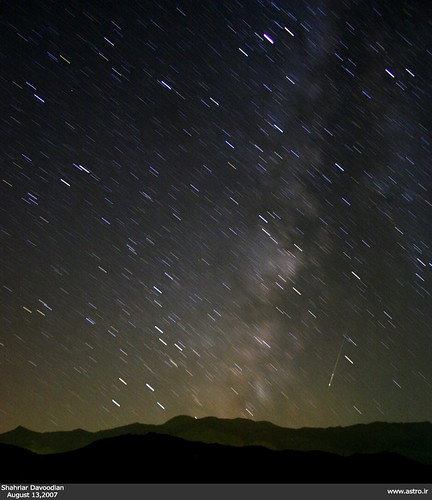Perseids Light Up The Sky

Astronomy buffs throughout the Northern Hemisphere have been staying up late recently to view the Perseids meteor shower, which peaked on August 12th during the new moon.
Spaceweather.com has a fine collection of photographs of the meteor shower. (The photo above is taken from their collection.)
At its peak Sunday night, the Perseids awed observers with up to 80 meteors per minute visible in a clear sky.
We’ve been fans of the Perseids since the early 1990s, when the comet Swift-Tuttle — the parent body of the Perseid meteor cloud — made its closest pass to earth since Abe Lincoln was president. The proximity of Swift-Tuttle meant that the Perseids were particularly spectacular during our salad days of 1993.
None of us, however, are likely to be around for the comet’s next perihelion passage in August of 2126 (when it may be as bright as Hale-Bopp), but until then the Perseids’ peak — usually August 12th — remains one of the best nights of the year to set up an astronomy date.
Several years ago, Space.com published a great article featuring the Top 10 Perseid Meteor Shower facts. Among them:
1. Perseid meteoroids (which is what they’re called while in space) are fast. They enter Earth’s atmosphere (and are then called meteors) at roughly 133,200 mph (60 kilometers per second) relative to the planet. Most are the size of sand grains; a few are as big as peas or marbles. Almost none hit the ground, but if one does, it’s called a meteorite.
2. Comet Swift-Tuttle, whose debris creates the Perseids, is the largest object known to make repeated passes near Earth. Its nucleus is about 6 miles (9.7 kilometers) across, roughly equal to the object that wiped out the dinosaurs.
3. Back in the early 1990s, astronomer Brian Marsden calculated that Swift-Tuttle might actually hit Earth on a future pass. More observations quickly eliminated all possibility of a collision. Marsden found, however, that the comet and Earth might experience a cosmic near miss (about a million miles) in 3044.
Check out the complete article (and 7 other interesting facts) here.